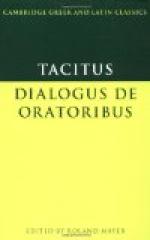EUXINE, or PONTUS EUXINUS; now the Black Sea.
F.
FERENTINUM, a town of Latium, in Italy; now Ferentino,
in the
Campania of Rome.
FERENTUM, a town of Etruria; now Ferenti.
FERONIA, a town in Etruria.
FIDENAE, a small town in the territory of the Sabines, about six miles to the north of Rome. The place where the ruins of Fidenae are seen, is now called Castello Giubileo.
FLAMMINIAN WAY, made by Flamminius A.U.C. 533, from Rome to Ariminum, a town of Umbria, or Romana, at the mouth of the river Ariminus, on the gulf of Venice. It is now called Rimini.
FLEVUS, a branch of the Rhine, that emptied itself into the lakes which have been long since absorbed by the Zuyderzee. A castle, called Flevum Castellum, was built there by Drusus, the father of Germanicus.
FORMIAE, a maritime town of Italy, to the south-east of Cajeta. The ruins of the place are still visible.
FOROJULIUM. See FORUM JULIUM.
FORUM ALLIENI, now Ferrare, on the Po.
FORUM JULIUM, a Roman colony in Gaul, founded by Julius Caesar, and completed by Augustus, with a harbour at the mouth of the river Argens, capable of receiving a large fleet. The ruins of two moles at the entrance of the harbour are still to be seen. See Life of Agricola, s. 4. note a. The place is now called Frejus.
FRISII, the ancient inhabitants of Friesland.
See Manners of the
Germans.
FUNDANI MONTES, now Fondi, a city of Naples,
on the confines of the
Pope’s dominions.
G.
GABII, a town of Latium, between Rome and Preneste. A particular manner of tucking up the gown, adopted by the Roman consuls when they declared war or attended a sacrifice, was called Cinctus Gabinus. The place now extinct.
GAETULI, a people of Africa, bordering on Mauritania.
GALATIA, or GALLOGRAECIA, a country of Asia Minor, lying between Cappadocia, Pontus, and Pophlagonia; now called Chiangare.
GALILAEA, the northern part of Canaan, or Palestine, bounded on the north by Phoenicia, on the south by Samaria, on the east by the Jordan, and on the west by the Mediterranean.
GALLIA, the country of ancient Gaul, now France. It was divided by the Romans into Gallia Cisalpina, viz. Gaul on the Italian side of the Alps, with the Rubicon for its boundary to the south. It was also called Gallia Togata, from the use made by the inhabitants of the Roman Toga. It was likewise called Gallia Transpadana, or Cispadana, with respect to Rome. The second great division of Gaul was Gallia Transalpina, or Ulterior, being, with respect to Rome, on




